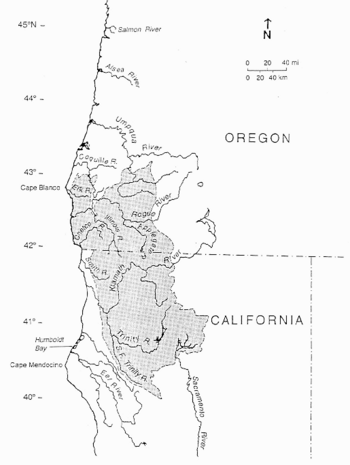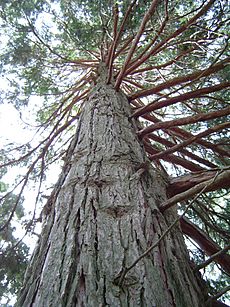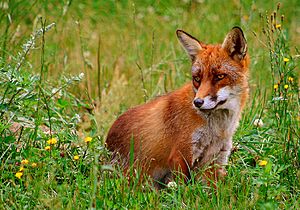Klamath Mountains facts for kids
Quick facts for kids Klamath Mountains |
|
|---|---|
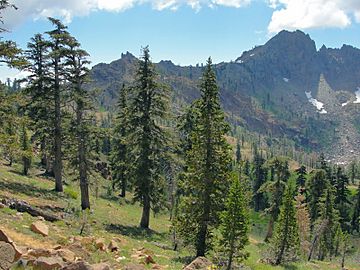
Mixed conifer forest in the Trinity Alps
|
|
| Highest point | |
| Peak | Mount Eddy |
| Elevation | 9,025 ft (2,751 m) |
| Listing | |
| Dimensions | |
| Length | 249 km (155 mi) |
| Width | 181 km (112 mi) |
| Area | 25,595 km2 (9,882 sq mi) |
| Geography | |
| Country | United States |
| Range coordinates | 41°19′12″N 122°28′44″W / 41.32°N 122.479°W |
| Parent range | Pacific Coast Ranges |
The Klamath Mountains are a wild and beautiful mountain range. They are found in northwestern California and southwestern Oregon in the western United States. These mountains are part of the larger Pacific Coast Ranges.
The Klamath Mountains have a very interesting geology, with special rocks like serpentinite and marble. The weather here has cold winters with lots of snow. Summers are warm and very dry, especially in the southern parts. Because of the unique rocks and soil, these mountains are home to many trees that grow nowhere else. They have one of the largest collections of conifer trees in the world! You can also find many different animals and fish here. This includes black bears, large cats, owls, eagles, and several types of Pacific salmon. Millions of acres in these mountains are protected by the United States Forest Service. The biggest part of the Klamath Mountains is called the Siskiyou Mountains.
Contents
Exploring the Klamath Mountains
The Klamath Mountains are made up of several smaller mountain groups. These include the Siskiyou Mountains, Marble Mountains, Scott Mountains, Trinity Mountains, Trinity Alps, Salmon Mountains, and the northern Yolla-Bolly Mountains. These mountains are a special part of California's natural landscape.
Highest Peaks in the Klamath Mountains
Here are the ten tallest mountains in the Klamath Mountains:
- Mount Eddy (in Trinity and Siskiyou County, California; 9,029 feet or 2,752 meters tall)
- Thompson Peak (in Trinity and Siskiyou County, California; 8,994 feet or 2,741 meters tall)
- Mount Hilton (in Trinity and Siskiyou County, California; 8,934 feet or 2,723 meters tall)
- Caesar Peak (in Trinity and Siskiyou County, California; 8,920 feet or 2,719 meters tall)
- Sawtooth Mountain (in Trinity County, California; 8,891 feet or 2,710 meters tall)
- Wedding Cake Mountain (in Trinity County, California; 8,570 feet or 2,612 meters tall)
- Caribou Mountain (in Siskiyou County, California; 8,564 feet or 2,610 meters tall)
- China Mountain (in Siskiyou County, California; 8,551 feet or 2,606 meters tall)
- Gibson Peak (in Trinity County, California; 8,403 feet or 2,561 meters tall)
- Boulder Peak (in Siskiyou County, California; 8,299 feet or 2,530 meters tall)
Protected Natural Areas
A large part of the Klamath Mountains is managed by the United States Forest Service. This means these areas are protected and cared for. Several national forests are located here. These include the Shasta-Trinity National Forest, Siskiyou National Forest, Klamath National Forest, Six Rivers National Forest, and Mendocino National Forest.
The Klamath Mountains also have 11 special wilderness areas. These are places where nature is left wild and untouched. They are found in both Oregon and California:
- Chanchelulla Wilderness
- Kalmiopsis Wilderness
- Marble Mountain Wilderness
- Mount Lassic Wilderness
- North Fork Wilderness
- Red Buttes Wilderness
- Russian Wilderness
- Siskiyou Wilderness
- Soda Mountain Wilderness
- Trinity Alps Wilderness
- Yolla Bolly-Middle Eel Wilderness
Fun Things to Do in the Klamaths
The Klamath Mountains are a great place for outdoor adventures! There are many hiking trails, recreation spots, and campgrounds. You can find both simple and more developed places to stay.
A 211-mile (340 km) part of the famous Pacific Crest Trail (PCT) goes through these mountains. This section is known as "The Big Bend." It marks where the plants change from California's unique types to those found in the Cascades.
The Bigfoot Trail is another long trail, about 400 miles (640 km) long. It winds through the Klamath Mountains from the Yolla Bolly-Middle Eel Wilderness all the way to Crescent City, California.
How the Mountains Were Formed
The rocks of the Klamath Mountains started out as island arcs. These were like chains of volcanoes in the Pacific Ocean. They also included pieces of older continents. These island pieces moved eastward and crashed into the North American Plate over millions of years. This happened between 260 and 130 million years ago. Each crash added a new layer of rock to the continent.
During these crashes, the intense pressure and heat changed the rocks. This process is called metamorphism. It also created hot, melted rock called magma. This magma pushed into the other rocks. Common rocks found here include Serpentinite, which comes from changed ocean rocks, and other rocks like gabbro and granodiorite. Later, lava flows from volcanoes in the Cascade Range covered some of these older rocks.
Amazing Plants and Animals
Flora: The Plants of the Klamaths
Because of their unique geology, these mountains have a huge variety of plants. You can find different plant groups here, like temperate rain forests, moist inland forests, oak forests, and high-elevation forests. These areas form the Klamath Mountains ecoregion. One common plant community is the Mediterranean California Lower Montane Black Oak-Conifer Forest.
The Klamath Mountains are home to several plant species that grow only here or almost only here. These are called endemic species. Examples include Port Orford cedar (Chamaecyparis lawsoniana), foxtail pine (Pinus balfouriana spp. balfouriana), and Brewer's spruce (Picea breweriana). This makes the Klamath Mountains one of the best places in the world to see many different kinds of conifer trees. Another endemic plant, Kalmiopsis leachiana, is a flowering plant found only in the Siskiyou Mountains in Oregon.
Conifers: A World of Trees
The Klamath Mountains have an amazing number of different conifer trees. There are about 30 different conifer species here! This includes two endemic species: the Brewer's spruce and the Port Orford cedar. This makes the Klamath Mountains one of the richest conifer forest regions in the world. The area also has special plant groups that grow on unique soil types, especially on serpentine rocks.
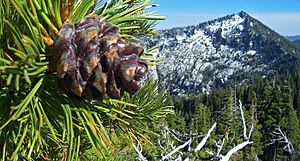
In 1969, two scientists, Dr. John O. Sawyer and Dale Thornburgh, found 17 species of conifers in just one square mile (2.6 km²) near Little Duck Lake and Sugar Creek. This area is in the Russian Wilderness. They called this incredibly diverse spot the "Miracle Mile." In 2013, another scientist, Richard Moore, found an 18th species, western juniper, in the Sugar Creek canyon. This small area is now considered the richest place on Earth for conifer diversity in a temperate climate.
Some of the conifer species you can find in the Klamath Mountains include:
- coast Douglas-fir (Pseudotsuga menziesii ssp. menziesii)
- Port Orford cedar
- ponderosa pine (Pinus ponderosa)
- sugar pine (Pinus lambertiana)
- mountain hemlock (Tsuga mertensiana)
- white fir (Abies concolor var. lowiana)
- red fir (A. magnifica var. shastensis)
- Brewer spruce
- coast redwood (Sequoia sempervirens)
- western red cedar (Thuja Plicata)
- Pacific yew (Taxus brevifolia)
- Western White Pine
- Lodgepole Pine
- Whitebark Pine
- Incense Cedar
- Foothill Pine
- Foxtail Pine
- western Juniper
- Jeffrey Pine
The westernmost group of Quaking Aspen trees in the United States is found in the northern part of the Yolla Bolly-Middle Eel Wilderness.
Trinity Alps Flora
In the Trinity Alps region, you'll often see trees like Douglas fir, ponderosa pine, red fir, and white fir. Other common trees include black oak, canyon live oak, Pacific madrone, bigleaf maple, California Buckeye, incense cedar, and Jeffrey pine. The northernmost group of gray pine (Pinus sabiniana) in California grows here along the South Fork of the Salmon River.
Fauna: The Animals of the Klamaths
The huge, wild forests and few human settlements make the Klamath Mountains a perfect home for many animals. You might spot mountain lions, black bears, bobcats, lynx, raccoons, martens, fishers, beavers, grey fox, red fox, northern flying squirrel, and lots of black-tailed deer.
Many birds live here too. These include golden eagles, bald eagles, pileated woodpeckers, Flicker woodpeckers, band-tailed pigeons, and several types of hawks like goshawks and Red-tailed hawks. You can also find large owl species, including the spotted owl, plus many other kinds of birds and animals.
Long ago, Grizzly bears, gray wolves, and mule deer lived in this area. However, they were hunted out by early European settlers. A project to bring back Roosevelt elk started in 1985. Now, elk can be seen roaming throughout the Marble Mountain Wilderness and Trinity Alps Wilderness. They also live in the northern Siskiyou Mountains and along the South Fork of the Salmon River.
Some of the most remote parts of these mountains are known for supposed Bigfoot or Sasquatch sightings. This legendary creature is also part of the folk tales of the Native American people who live here.
Rivers and Fish: Waterways of Life
Important rivers and lakes in the Klamath Mountains include the Klamath River, Trinity River, Smith River, Salmon River, Rogue River, Scott River, upper Sacramento River, Chetco River, Mad River, Van Duzen River, Applegate River, Illinois River, Elk River, South Umpqua River, South Fork Coquille River, Shasta Lake, Trinity Lake, Ruth Lake, Castle Lake, Applegate Lake, and Whiskeytown Lake.
These many streams and rivers are major places where different kinds of trout and salmon lay their eggs. However, in the last 50 years, the number of fish, especially salmon, has dropped a lot. The rivers and streams here are home to nine types of native salmonids (fish in the salmon family). This decline is mainly because of dams being built and too much logging. Logging can cause a lot of dirt and mud (silt) to wash into the rivers. This silt covers the gravel beds where salmon lay their eggs, making it hard for them to reproduce.
Some of the notable fish species you can find are king, kokanee, and silver salmon. There are also brown, brook, and rainbow trout (including steelhead), cutthroat trout, and fish like crappie, bluegill, catfish, and largemouth and smallmouth bass.
See also
- The Klamath Knot


